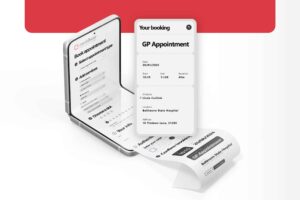Healthcare today faces a paradox: advances in technology have the potential to make clinics more efficient, yet many organisations find themselves buried under fragmented systems, duplicate data, and rising administrative costs. According to the World Health Organization, global health systems face a projected shortfall of 10 million healthcare workers by 2030 if inefficiencies are not addressed. For clinics, efficiency is no longer a “nice to have” but a necessity for survival.
The right clinic software can be the difference between an organisation that thrives under increasing pressure and one that drowns in inefficiencies. With dozens of options on the market, decision makers must cut through the noise and evaluate what truly drives operational success.
The Rising Pressure on Clinics: Where Inefficiency Hurts Most
The efficiencies in healthcare occur daily in clinics around the world.
- Missed appointments and wasted resources: In the UK, the NHS reported over 7.8 million missed GP appointments in 2022, costing an estimated £620 million. For clinics, software that automates scheduling and reminders can directly protect revenue.
- Data silos and compliance risk: In the United States, one study found that 92% of healthcare organisations experienced at least one cyber attack involving electronic patient records in the last 12 months. Many of these breaches stem from fragmented or outdated systems that fail to provide secure, centralised storage.
- Administrative burden: A Canadian study found that physicians spent 1.36 million hours a year on administrative tasks, with doctors reporting that 500,000 hours of this work was unnecessary.. This directly contributes to burnout, a crisis that now affects more than 40% of clinicians globally.
The message is clear: inefficiency is not just inconvenient, it is financially and clinically damaging.
Key Features of Modern Clinic Software Driving Efficiency
Integrated Patient Scheduling
A good scheduling system is the backbone of operational efficiency. Clinics that adopt automated scheduling tools have seen no-show rates drop by 38% on average. Features like online booking, automated SMS/email reminders, and capacity-based slotting help fill calendars efficiently and ensure resources are used to their fullest.
Electronic Health Records (EHR) Integration
Fragmented patient data is one of the most common barriers to efficiency. Unified EHR systems allow clinicians to access complete patient histories instantly, reducing duplication and error. Cloud-based platforms, such as Meddbase, take this further by enabling real-time updates across multiple locations without the need for costly server infrastructure. Clinics moving to cloud-hosted records often report IT cost reductions of 20–30% within the first year.
Data Security and Compliance
Data breaches are both costly and damaging to patient trust. In 2023, the average healthcare data breach cost reached $10.93 million per incident, the highest across all industries. Modern clinic software mitigates this risk through built-in compliance frameworks (HIPAA, GDPR) and encrypted cloud storage. Meddbase, for example, provides audit trails and access control features that give administrators confidence in regulatory compliance.
Interoperability with Other Healthcare Tools
Clinics don’t operate in isolation. They need to connect with labs, pharmacies, insurers, and telemedicine providers. Interoperable software that offers APIs and modular integration can prevent bottlenecks and data duplication. For instance, Meddbase integrates with pathology services and billing systems, ensuring that workflows are continuous rather than fragmented.
How Clinic Software Improves Operational Efficiency
The benefits of adopting the right clinic software ripple across operations:
- Reduced administrative burden: Automation of invoicing, referrals, and reporting frees staff to focus on patient care. A case study from Alberta found that clinics adopting digital referral management reduced manual paperwork by 50%, cutting referral processing time from weeks to days.
- Better patient outcomes: Real-time access to records reduces the risk of medical errors. A study published in Nature Digital Medicine found that a transition from a paper-based to a fully digital hospital, including EHR, computerized provider order entry (CPOE), and clinical decision support, resulted in a drop from 52.8% to 15.7% in medication order errors.
- Scalability for growth: Clinics that rely on outdated systems often discover that scaling beyond one or two locations is nearly impossible. Cloud-based systems provide elasticity, allowing clinics to expand patient volumes and geographic reach without infrastructure overhauls.
Evaluating Clinic Software: What Decision Makers Should Look For
When selecting software, clinic leaders should assess more than just price. The following criteria are crucial:
- Ease of use: Complex software leads to staff frustration and training costs. Look for intuitive interfaces.
- Scalability: Software should grow with your organisation, not hold it back.
- Consolidation: Fewer systems mean fewer integration points, less duplication, and lower risk.
- Vendor reliability: Long-term support, regular updates, and industry experience matter.
Here, Meddbase stands out because of our 20+ years of experience in occupational health and clinical software, with a proven ability to consolidate patient management, billing, scheduling, and reporting into a single secure platform. For buyers, this level of maturity signals reliability in a market crowded with startups and niche products.
Trends Your Provider Should Keep up With
Any clinic software provider should deliver the basics; secure data storage, reliable uptime, and compliance with regulations. But what sets a strong provider apart is their ability to anticipate what’s coming next. If your system only meets today’s needs, you risk constantly playing catch-up. A forward-looking platform helps you stay aligned with the evolving expectations of both patients and clinicians, ensuring your organisation remains competitive and prepared for the future
Artificial Intelligence and Predictive Analytics
AI is moving from hype to reality in healthcare. Predictive analytics can forecast patient flow, identify at-risk patients, and optimise resource allocation. According to McKinsey, applying early successes at scale could reduce US healthcare costs by $300 billion to $450 billion.
Telehealth Integration
Virtual care is no longer optional. In 2024, it was reported that 54% of Americans have used telehealth services, with 38% using it for medical or mental health needs. Software that embeds telemedicine into its core functionality ensures clinics can meet this rising demand.
Mobile Access for Clinicians
Clinicians increasingly expect secure mobile access to patient records while on the move. An ACP study found that among physicians using an EHR, 75% rely on smartphones and 33% use tablets for clinical tasks. Choosing a platform that adapts seamlessly across devices, whether large desktop screens or smaller mobile interfaces, ensures your EHR delivers maximum usability and keeps pace with the realities of modern clinical practice.
Cloud-First Models
Global health IT spending on cloud solutions is projected to reach $89 billion by 2027, doubling from 2022. The shift is driven by the need for resilience, flexibility, and cost reduction. Vendors like Meddbase, which are already cloud-native, are positioned ahead of the curve.
Building a More Efficient Clinic with the Right Software
Efficiency is not about adopting the most tools, but the right ones. For clinics, the right software must unify scheduling, patient records, billing, and compliance into a cohesive system. It should reduce administrative workload, strengthen patient care, and adapt as the clinic grows.
Decision makers should prioritise platforms that combine scalability, interoperability, and data security. While many vendors make promises, only a handful—like Meddbase—have demonstrated the long-term commitment and consolidation needed to meet today’s healthcare challenges.
The future of healthcare efficiency lies not in adding complexity, but in simplifying operations through the right technology. Clinics that make smart software investments today will be better equipped to deliver care tomorrow.





